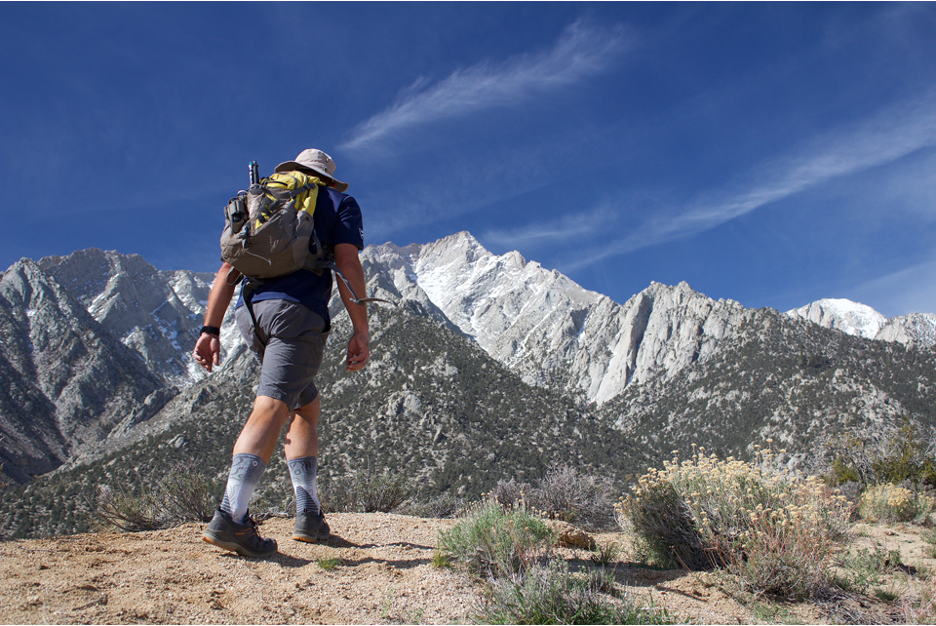
The Big Dilemma: Balancing Space and Weight
For diabetics who enjoy the adventure of a trek in the backcountry, experience tells us everything we need to prep for. As we pack for our adventures, we critique our supplies as we try to pare down the “bring-along” items, deciding between necessity and luxury. We have two factors to consider in the things we cram into our trusty little excursion packs: space and weight.
For experienced backpackers, this is always a fun little exercise to see all our provisions laid out and inventoried before meticulous stowage (cramming) into all the nooks and caverns in our backpack or vest, or in the pockets of our jackets, shorts and pants. All while trying to avoid that small bird of burden sitting on our shoulder whispering, “Bring it, you might need it.”
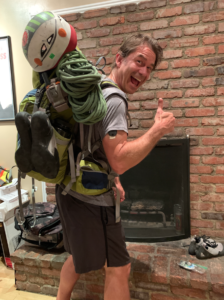
Overpacking is just human nature, and, while comforting and reassuring to know we have everything we might need, it does add up to more weight and less space in our pack. There are some of us who know just how to dance with this devil each time we pack for a trip, and there are others who are just being introduced to the “Oh, I think I’m gonna need to bring this,” for the first time.
The Unique Needs of People with Diabetes
Diabetics have an additional layer of essentials to add to this daunting list; necessary medical supplies that can NOT be left behind if headed out for any length of time more than a few hours. The range of diabetic-necessary medical supplies varies greatly from person to person and this list really is defined by how he or she is managing their diabetes, whether by insulin pump therapy, MDI (multiple daily injections) additional oral meds, or a combo of each.
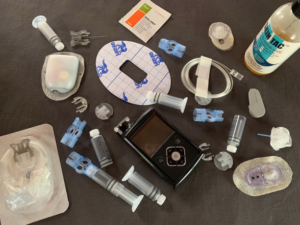
There’s also a vast variety of methods in which diabetics are monitoring blood sugar, whether by test strips and a glucometer or by any number of CGMs on the market. Each one of these variables has its very own manifest of additional supplies, either for general maintenance, recharging, infusion site changes, adhesives, or backups for each in case one breaks or fails.
And then, there’s the all-important insulin. All type 1 diabetics need it. Insulin has its own world of variables, besides the different types, strengths and styles, whether it comes from a glass vial, a pen, or powder, and its many delivery methods from pumped and injected to inhaled, and I haven’t even mentioned the list of delivery devices for each of these. But you get the idea. There’s a LOT of supplies needed for insulin delivery.
You may be thinking geez, diabetics have the odds stacked against them in wanting to get out there onto backcountry expeditions. Probably safer to stay indoors where diabetes can be controlled in a safe environment with little to no risk of anything going wrong or left behind. But is that any way to live?
For some – no.
Also for me – no. Though of course you should talk to your doctor about appropriate activities for you.
Here’s where I take a critical look at the essential type 1 diabetes supplies that MUST come along on a backcountry expedition.
The Diabetes Essentials
There are just three (maybe four) T1D “essentials”. Most of us can already guess what our essential T1D items are. We already pack them along on even the smallest outings, whether a quick trip to the grocery store, a picnic with friends, or even a few days traveling. With confidence, each diabetic has his or her own manifest of essential diabetes items that we can’t leave home without.
Speaking for myself, my main T1D essentials are:
1. Insulin
2. Emergency Glucose
3. BG measuring/monitoring
4. Power (when needed for recharging gadgets)
This is a variable list and might change depending on the outing. Flexibility is key.
Insulin
Absolute top of the list. Without it, we die in a few days. I used to be a pumper. And, yes I used to haul pump supplies into the backcountry in a small, lunch box-sized, flexible container that occupied about 2100 cubic cms (or 128 cubic in). My liquid insulin, in a pen or a vial, was kept cool inside a Frio insulin cooling pouch which would usually be kept company with a backup vial in case a vial broke, and would travel with an emergency syringe just in case the pump was out of commission.
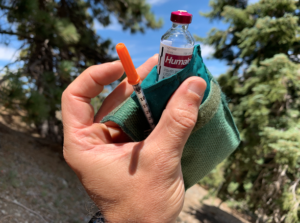
This evaporative pouch would need to travel in an outer mesh section of the pack to allow for proper evaporation (which is how the pouch refrigerates the contents). Throw in the usual pump supplies needed for frequent three-day site changes (pump reservoirs, tubing, infusion sets, backups for each in case of failure, extra batteries for the pump) and you can see that the ‘bulk’ already is pretty significant. (Oh and I didn’t mention that in some cases an emergency backup pump – yes, a whole new pump – for extended, multi-week-long expeditions in remote destinations, was sometimes thrown in for insurance).
You may have noticed in the previous description that I used to wear a pump. Well, that’s because almost two years ago I went on a “pump break”. The main reason was mostly burnout and I needed to mix things up and find solutions for my lifestyle, which had become more and more active with bigger backcountry excursions, more trail running, mountaineering, rock climbing, etc. and I needed to find solutions that didn’t require me disconnecting from the pump so often, which was leading to worsening blood sugar control.
I spoke with a few endocrinologists about wanting to take a pump break, and each had their own solutions to offer including a variety of different insulins to take with different insulin regimens. Much of what was suggested wasn’t really a solution to my burnout – they were the same burden, just different.
That was until Dr. Kayne made one suggestion for me that really resonated. His solution was one shot a day of Tresiba for my basal insulin, and Afrezza (insulin human) Inhalation Powder – made by MannKind* – for all my meals and corrections, with the occasional supplement of Humalog from a pen, if needed, for larger, high protein meals.
A couple of days into this new, pump-free insulin regimen, I was elated! An amazing sense of liberation! It felt like the weight of this burden, the heavy weight of this “brick” in my pocket, was finally lifted.
Afrezza
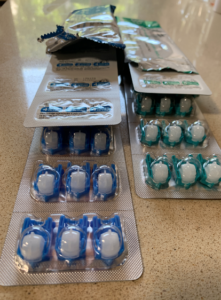
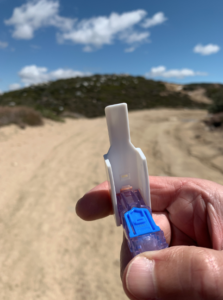
Oh and let me tell you about Afrezza! It’s an inhalable insulin powder that comes in small cartridges of 4 units, 8 units, and 12 units. The inhaler and cartridges are small, pocket-size, and do not require constant refrigeration. Though Afrezza should be stored in the refrigerator once picked up from the pharmacy, unopened blister cards or strips can be stored at room temperature for up to 10 days. After the foil is punctured, the cartridges can be stored at room temperature for up to three days. You should not put Afrezza back into the refrigerator after being stored at room temperature. It is also very light weight (I’m talking grams at most).
These cartridges can be carried in my pocket along with the inhaler in practically any outdoor activity except swimming, and even still, I’ve found a Ziploc bag solves this dilemma. I bring this pocket insulin along on hikes, runs, multi-pitch rock climbing, and mountaineering expeditions. It fits easily into a bear canister for safe storage at night. Dosage is a lot looser than dialing in a correction factor or carb count bolus. The initial dose is determined based on converting from your subcutaneous dose using a chart, and then titrated based on response.
One very cool aspect of Afrezza is its action time. It’s RAPID! Like one of the fastest acting insulins available. It’s in the bloodstream in minutes after taking it, and its action begins in as little as 12 minutes. In my opinion, the best part is that it’s out of my system in 90 minutes to 3 hours, depending on the dose. I did need to do a lung function test before getting prescribed the Afrezza, but since I have no history of chronic lung disease, this was an easy test to pass for me.
Important Safety Information:
What is the most important information I should know about AFREZZA?
AFREZZA can cause serious side effects, including:
Sudden lung problems (bronchospasms). Do not use AFREZZA if you have long-term (chronic) lung problems such as asthma or chronic obstructive pulmonary disease (COPD). Before starting AFREZZA, your healthcare provider will give you a breathing test to check how your lungs are working.
What is AFREZZA?
AFREZZA is a man-made insulin that is breathed-in through your lungs (inhaled) and is used to control high blood sugar in adults with diabetes mellitus.
AFREZZA is not for use in place of long-acting insulin. AFREZZA must be used with long-acting insulin in people who have type 1 diabetes mellitus.
AFREZZA is not for use to treat diabetic ketoacidosis.
It is not known if AFREZZA is safe and effective for use in people who smoke. AFREZZA is not for use in people who smoke or have recently stopped smoking (less than 6 months).
It is not known if AFREZZA is safe and effective in children under 18 years of age.
Please see additional Important Safety Information for Afrezza below.
Blood sugar control can’t have all the credit go to just one medication or one device. The other credit needs to go to my long-acting basal insulin, which is the one-shot-a-day Tresiba. I have to say, for a long-acting insulin, this stuff has worked well for me. With most insulins, there’s a “peak” in its action, where it appears to work the strongest. During those peak times, many diabetics find that this is where they experience the most “lows” before the insulin’s strength wears off. This is happening, usually, over the course of hours while the insulin is in the system.
Tresiba
The thing that Tresiba has going for it is that it has no remarkable “peak” in its action, and it has an “effective” action range of about 24-36 hours. It can be detected in the system up to 72 hours, which means that even if I miss a shot, or am running late for a shot (like hours), I won’t feel any of the adverse effects of depleted basal insulin on board, which is bound to happen from time to time if I’m in some adverse backcountry conditions. I must add that if I’m taking this Tresiba pen with me into the backcountry on an excursion, I’ll need to keep it cool since it is a liquid insulin after all. So for this, I’ll keep it in a thin Frio pouch or a Tempramed cooling insulin pen cap. The only other accessory for this insulin that I’ll need is a couple of fresh pen needles.
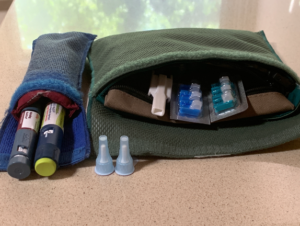
Emergency Glucose
There seems to be three states of blood glucose for all diabetics:
- High
- Low
- In Range
Two of these states are “functional” states. The state in which most diabetics cease to function properly is the “low” state. Hypoglycemia is that one state of low blood sugar that can be so serious in some people that it’s possible to lose consciousness. Often, fear is the only driving instinct that keeps us from actually going so low that we might need intervention. Diabetics know all too well the horrible feeling a hypo can present that we usually keep a handy supply of sweet treats in easy access. Hypoglycemia tends to hamper our abilities to make good decisions, in about any place we happen to experience low blood sugar.
Having a hypo in the backcountry is probably the most concerning because of the extra awareness of our surroundings needed, from the simple forest trek keeping a keen eye out for bears, to the more extreme in mountaineering on precarious rock ledges.
Speaking for myself, I usually bring a glucose gel in my pocket whenever I’m out of the house. If on a mountain hike, I may keep two or three gels in my pockets handy. Now my own experiences will inform me that cardio, like running or hiking, will tend to drop my blood sugar, while anaerobic activities like weight lifting or rock climbing, will tend to raise my blood sugar. The activity type usually determines what and how much emergency glucose I’ll keep on hand.
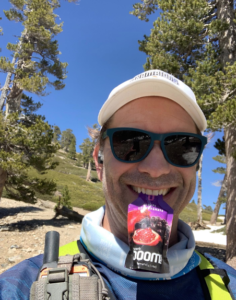
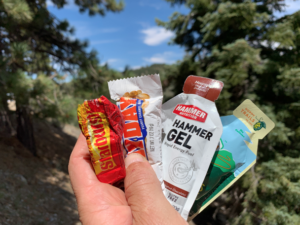
On backcountry expeditions, it’s not unusual that I’ll bring along a collection of gels and granola bars in my backpack, mostly as a backup for low blood sugar, and to take during breaks during a hike. It’s an easy place to restock my pockets with the surplus I keep in the pack. This is a separate provision from meals that I might be packing. I’ll try to keep breakfast, lunch, dinner and snacks as close to normal, or what a non-diabetic might pack for a backcountry excursion.
Glucose Measuring/Monitoring
The one thing that stuck with me during my conversations with Dr. Kayne, the prescriber of my pump freedom, is he said that going on a pump break is relatively easy, but CGM is key. Continuous Glucose Monitoring allows for careful observation of blood sugars while undergoing rapid metabolic changes, which happens when switching from different insulins or during exercise – both of which describe me! In my opinion, I’d have to say that one of the biggest leaps in diabetes management in the past decade has to be CGM technology.
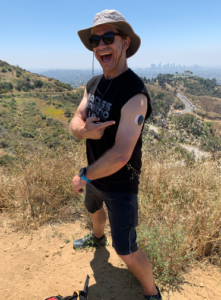
There’s a whole world of CGM tech out there, and the buzz in the community is most likely the ‘looping’ capabilities, where a CGM can communicate with a user’s pump and automatically make insulin dosage adjustments based on blood glucose value trends. This is cool – there’s no doubt about that. Am I interested in using loop technology for myself? Not really. For me, it doesn’t give me the pump freedom I want. I’m happy using a CGM to see my glucose values and trends, making my own decisions, and dosing accordingly using Afrezza. Why? Tech can only predict so much.
For example, a closed-loop system may see a rising blood glucose value and want to give me a small insulin dose to correct that glucose rise. But what the tech doesn’t see is that I want that rising glucose in place before I begin an ascent up a 900m ridge on hard 3rd class scree. Call me a control freak, but I’m the captain here, and I know what I’m doing. So to speak.
The Eversense CGM
The CGM system I use is the Eversense CGM. A fully implanted sensor that uses fluorescence to measure glucose values. A long-term implanted sensor can last for, well, indefinitely. At the moment the FDA in the U.S. says we can only keep our sensors in for three months at a time. In Europe they’re allowed to keep them in for six months at a time.
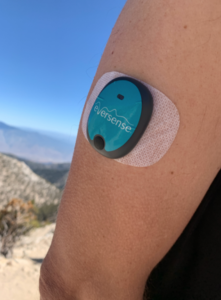
Using near field communication (NFC), the sensor transmits glucose values to a Bluetooth transmitter that I wear on top of my skin above the sensor, which, in turn, transmits those values to my phone or watch. The nice thing about this setup is that I can remove the transmitter whenever I want, so I don’t have to baby this thing, and there’s less risk of it falling off when playing in some rough, rocky terrain or while swimming in the surf.
Once I’m ready, I can simply put the transmitter right back on top with a double-sided sticky.
The transmitter vibrates whenever there’s an alert for me, like rapidly falling or rising glucose levels. So if for some reason I can’t see or hear my phone alerts, the transmitter will vibrate a specific vibration pattern to let me know what’s going on – my blood glucose values are high, low, rising, falling, etc. That’s very cool!
Oh, and one more thing. Since I get to remove the transmitter whenever I want, and I’m no longer wearing a pump…. naked showers every day! (Ask any diabetic – they’ll tell you!)
On backcountry trips, I’ll always bring along a backup glucometer, just in case of any CGM failure. My system is a very robust and reliable CGM, but it’s tech, and tech always has the potential to fail. There’s very little room for failures in the backcountry, so a backup is always part of my essentials for glucose measuring.
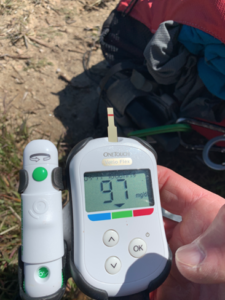
Backup Power
Gadgets, am I right?
Backup power isn’t typically seen as a life & death, mission-critical necessity, but more and more gadgets are infused into our “norm” that it’s going to be hard to ignore them from our essentials list. The two main pieces of gadgetry for modern-day diabetics are pumps and CGMs. In addition, there are a host of new gadgets that diabetics keep on blazing trails with – things like smartwatches, smart insulin pens, insulin cooling caps and canisters, glucometers, personalized diabetes managers (PDMs), CGM receivers, smartphones, smart CGM transmitters, flash technology receivers, and a whole collection of smartphone apps to control and monitor all of it.
And all these gadgets need power.
Some just need a new battery every year. While others need to be recharged daily, and it’s for these rechargeable, power-hungry digital companions that we outdoors-driven diabetics need some way to recharge when there’s no power for days. And this isn’t even counting the potential array of electronics that make modern-day expeditions so much fun. Things like camera batteries, navigation devices, headlamps, satellite communicators, watches, headphones, etc.
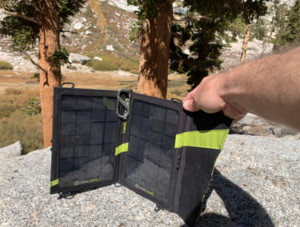
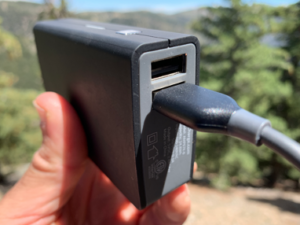
Besides the usual assortment of batteries I will pack along, my need for backup power depends on the outing.
If I’m out on a day hike (8 hours or less), a small 2600 mAh power bank with a USB plug and cord will do the job. Something to recharge my phone if the power drops below 20% (note: my phone is my CGM receiver).
For longer excursions (8 hours plus), I will bring along a power bank as well as my GoalZero solar charger. The model I use is the Nomad 7 which is discontinued now, but the GoalZero Nomad 10 is a worthy replacement. About the size of an iPad mini, it’s rugged, packs small, is light-ish weight, and an accessory pocket on the back holds all the cords. Only downside… the sun needs to be out. An afternoon recharge of all my rechargeable gadgets usually keeps my electronics alive through the night.
The Reward
Finally…diabetic essentials don’t always have to be tangible things.
There’s such a thing as “Wilderness Therapy”. I didn’t invent it – in fact it’s been around since therapy was therapy, and even before that. But it’s something that I, and others, seek out when heading for adventure in the outdoors. It’s hard to describe it without sounding all trippy hippy, but it’s a feeling, a sense of calm, an almost indescribable feeling of connection between self and nature. I often need to be really quiet to feel it, but when I do, it does amazing things.
If just starting out, take baby steps.
Make all your mistakes on small outings. Then do it all over again.
After all, experience tells us everything, and we have to start somewhere.
I hope I’ve provided some inspiration for those who are curious, or provided some humorous nostalgia for the experienced.
Feel free to follow me for more outdoor adventure inspiration:
Instagram: @typeoneoutdoors
Facebook: facebook.com/typeoneoutdoors/
YouTube channel: bit.ly/T1O-on-YouTube (or search Type One Outdoors)
Web: typeoneoutdoors.com
…or look for my logo while on the local trails in Southern California.
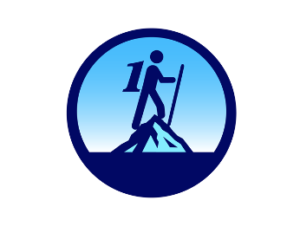
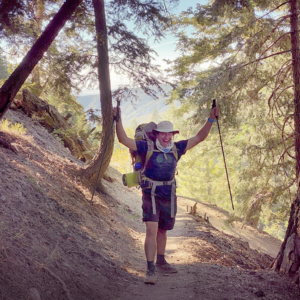
Important Safety Information:
What is the most important information I should know about AFREZZA?
AFREZZA can cause serious side effects, including:
Sudden lung problems (bronchospasms). Do not use AFREZZA if you have long-term (chronic) lung problems such as asthma or chronic obstructive pulmonary disease (COPD). Before starting AFREZZA, your healthcare provider will give you a breathing test to check how your lungs are working.
What is AFREZZA?
AFREZZA is a man-made insulin that is breathed- in through your lungs (inhaled) and is used to control high blood sugar in adults with diabetes mellitus.
AFREZZA is not for use in place of long-acting insulin. AFREZZA must be used with long-acting insulin in people who have type 1 diabetes mellitus.
AFREZZA is not for use to treat diabetic ketoacidosis.
It is not known if AFREZZA is safe and effective for use in people who smoke. AFREZZA is not for use in people who smoke or have recently stopped smoking (less than 6 months).
It is not known if AFREZZA is safe and effective in children under 18 years of age.
What should I tell my healthcare provider before using AFREZZA?
Before using AFREZZA, tell your healthcare provider about all your medical conditions, including if you:
Have lung problems such as asthma or COPD
Have or have had lung cancer
Are using any inhaled medications
Smoke or have recently stopped smoking
Have kidney or liver problems
Are pregnant, planning to become pregnant, or are breastfeeding. AFREZZA may harm your unborn or breastfeeding baby.
Tell your healthcare provider about all the medicines you take, including prescription and over-the-counter medicines, vitamins or herbal supplements.
Before you start using AFREZZA, talk to your healthcare provider about low blood sugar and how to manage it.
What should I avoid while using AFREZZA?
While using AFREZZA do not:
Drive or operate heavy machinery, until you know how AFREZZA affects you
Drink alcohol or use over-the-counter medicines that contain alcohol
Smoke
Do not use AFREZZA if you:
Have chronic lung problems such as asthma or COPD
Are allergic to regular human insulin or any of the ingredients in AFREZZA.
What are the possible side effects of AFREZZA?
AFREZZA may cause serious side effects that can lead to death, including:
See “What is the most important information I should know about AFREZZA?”
Low blood sugar (hypoglycemia). Signs and symptoms that may indicate low blood sugar include:
Dizziness or light-headedness, sweating, confusion, headache, blurred vision, slurred speech, shakiness, fast heartbeat, anxiety, irritability or mood change, hunger.
Decreased lung function. Your healthcare provider should check how your lungs are working before you start using AFREZZA, 6 months after you start using it, and yearly after that.
Lung cancer. In studies of AFREZZA in people with diabetes, lung cancer occurred in a few more people who were taking AFREZZA than in people who were taking other diabetes medications. There were too few cases to know if lung cancer was related to AFREZZA. If you have lung cancer, you and your healthcare provider should decide if you should use AFREZZA.
Diabetic ketoacidosis. Talk to your healthcare provider if you have an illness. Your AFREZZA dose or how often you check your blood sugar may need to be changed.
Severe allergic reaction (whole body reaction). Get medical help right away if you have any of these signs or symptoms of a severe allergic reaction:
A rash over your whole body, trouble breathing, a fast heartbeat, or sweating.
Low potassium in your blood (hypokalemia).
Heart failure. Taking certain diabetes pills called thiazolidinediones or “TZDs” with AFREZZA may cause heart failure in some people. This can happen even if you have never had heart failure or heart problems before. If you already have heart failure it may get worse while you take TZDs with AFREZZA. Your healthcare provider should monitor you closely while you are taking TZDs with AFREZZA. Tell your healthcare provider if you have any new or worse symptoms of heart failure including:
Shortness of breath, swelling of your ankles or feet, sudden weight gain.
Get emergency medical help if you have:
Trouble breathing, shortness of breath, fast heartbeat, swelling of your face, tongue, or throat, sweating, extreme drowsiness, dizziness, confusion.
The most common side effects of AFREZZA include:
Low blood sugar (hypoglycemia), cough, sore throat
These are not all the possible side effects of AFREZZA. Call your doctor for medical advice about side effects.
Please see full Prescribing Information and Medication Guide, including BOXED WARNING on Afrezza.com.
*MannKind is a paid sponsor of TCOYD.


Leave a Reply